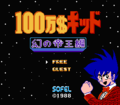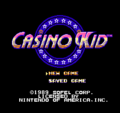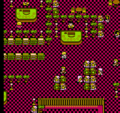Casino Kid is a casino game for the NES platform released in 1989. It was published and developed by Sofel. In Japan, the game was released as $1,000,000 Kid: Maboroshi no Teiou Hen (100万$キッド 幻の帝王編? lit. Million Dollar Kid: Imperial King Edition) and is based on the manga series $1,000,000 Kid by Yuki Ishigaki.
Casino Kid takes place in a fictional version of Las Vegas (the Japanese version uses the actual city of Las Vegas, Nevada) where the object is to earn lots of money and to defeat the evil King of the Casino. Games at the casino include blackjack and five-card draw poker. Slot machines and roulette were omitted from the North American version. While the North American version uses parody names for the Las Vegas casino, the Japanese version uses the actual Golden Nugget name. The layout in the Japanese version is similar to an actual Vegas casino compared to the North American version, which looks more like a glorified lobby.
In the Japanese version, it is possible to travel to other casinos like New York City and Japan for a substantial airfare cost. Players can essentially customize the game in the Japanese version by inputting their own name. Casino Kid has blue hair in the Japanese version and blond hair in the North American version. A "free mode" is added into the Japanese version that allow for experimentation with gambling strategies.
There is a different introduction in the North American and Japanese version. In the Japanese version, Hiroshi invites an unnamed kid to challenge the Phantom King in a Poker match, in the end it turns out that the Phantom King was Hiroshi in disguise. While the North American version has the player (as the Casino Kid) competing against the Casino King. Both versions have waitresses in bunny costumes that gives hints to the player. Attempting to skip an opponent allow players to find the exact location of the previous opponent while skipping two or more opponents is frowned upon in this game.
-
Japanese box art
-
Japanese title screen
-
American title screen
-
Screenshot
Controls
Draw Poker
| Name | Purse | Range | Location |
|---|---|---|---|
| Joseph | $1000 | $10–100 | Far South-east corner |
| Stephen | $2000 | $20–200 | North-west, in the slots |
| Ted | $3000 | $30–300 | Eastern wall |
| Lloyd | $12000 | $100–1000 | Western side, blackjack table |
| Whitney | $18000 | $200–2000 | At the bar, south-west |
| Jack | $70000 | $500–5000 | Poker table area, south-east |
| Pam | $100000 | $1000–10000 | Middle blackjack table |
| Cindy | $400000 | $5000–50000 | Near entrance |
| King | $1000000 | $10000-$100000 | Defeat all other challengers |
In Draw Poker, two players are dealt five cards after an initial Ante. After being dealt five cards, the players make an initial bet and are given four chances to raise the bet. They are given an opportunity to change some their card and make another round of betting.
Against the early opponents, it's possible to examine their expressions. In particular, Joseph and Stephan give clues about their hand, and Ted tends to show the opposite emotion. Starting with Lloyd, it becomes harder to determine if they have a good hand.
In this version of Poker, it is possible to defeat all computer opponents with a fixed betting pattern.
- If you are not comfortable with your hand (or it isn't viable), either fold, bet the minimum, or call.
- If you have a viable hand (at least one pair), make sure your bet is as low as possible while still requiring the other player to respond. This causes the opponent to respond with about 2-3 times the anti, and has no risk for him to fold if you try maxing your bet.
- If you started the bet and are on your second raise, make sure it is maximum.
After enough hands, the opponent offers to bet all money which you may either accept or decline. If the opponent is to the brink, decline it and force a victory by over betting him. In some cases, you may not be able to decline, such as if the opponent is critically low on funds.
When starting the game, you may want to try defeating all poker challengers up to Pam. After that, you can start on Blackjack with a large monetary advantage, or defeat Cindy to ensure that money won't be an issue in Blackjack. The final opponent, King, is available only after completing both Blackjack and Poker.
Blackjack
| Name | Purse | Range | Location |
|---|---|---|---|
| Lisa | $500 | $10–100 | South-west corner. |
| Martha | $1000 | $10–100 | Western wall. |
| Tom | $2000 | $100–1000 | North-east corner. |
| Harry | $8000 | $100–1000 | South-west of Tom. |
| Stefany | $12000 | $100–1000 | Next to the bar |
| Clyde | $50000 | $100–1000 | Middle |
| Bo | $70000 | $1000–10000 | North-west |
| Bruno | $250000 | $1000–10000 | Center, in enclosure. |
The objective of Blackjack is to get as close as possible to 21 without going over. The following rules apply:
- Bets are made before a hand.
- Jacks, Queens and Kings are worth 10. Aces are worth 11 if it won't cause you to go over; otherwise they're worth 1.
- Both the player and dealer are dealt two cards. The dealer has one face down.
- The player can ask to be Hit. This deals an extra card; if it goes over 21, the player is bust and loses the bet.
- The player can Stand. This causes the dealer to proceed with play.
- If the player has two cards, he may Double Down. This doubles the bet, and deals exactly one card. In this version, if both the player and dealer bust, it is considered a push.
- If these two identically-valued cards, he may Split. This splits the card into two different hands, as well as increasing the bat. These hands are played independently.
- Surrender returns half your bet, although there are restrictions when they can be performed.
- If the dealer's face up card is an Ace, you can place a side bet for "insurance". This is independent of the main bet, but allows you to recover funds if the dealer has blackjack. In general, you want to avoid insurance, unless most of the low cards are dealt out.
- When it's the dealer's turn, they deal until they reach at least 16 (hard or soft).
- The desk is shuffled about 2/3rds through the deck.
- Once the deck is shuffled twice, it's possible to bet beyond the limit by going "all-in".
To win blackjack, you need to count cards. The easiest way is to keep track of two separate counts of low and high cards. If a card is dealt between 2 and 6, it is "low"; a card between 10 and Ace is "high". If there are more low cards than high, you can make larger bets. There is no need to use paper, because the count can be performed verbally by saying the two totals after each hand. There are also other card counting systems as well, which work to different degrees.
In the regular casino, you may want to defeat the poker players up to Pam before attempting Blackjack. The betting speed of Blackjack is much slower and longer, and is more easily resolved by having a large amount of funds when you try forcing "all-in".



